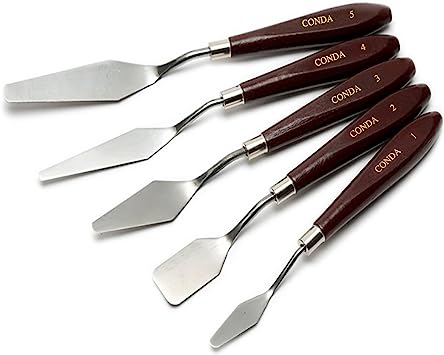Artists utilize numerous instruments to express their imagination. Palette knives are important painting tools. What does a palette knife do? This detailed introduction will cover the versatility of this painting tool and its uses in various artistic methods.
Understanding a palette knife’s possibilities might improve your painting skills and inspire new ideas.
What Is a Palette Knife?
Palette knife—what is it? Understand its nature before exploring its uses. Palette knives are versatile tools with blunt, flexible metal blades attached to handles.
Artists use this tool to mix colors, apply paint, and create unique textures and effects. Palette knives allow painters to apply paint more freely and passionately than brushes.
What Is a Palette Knife Used For?

Mixing Colors
An artist’s palette knife mixes colors. Its flat, wide blade is perfect for scraping, folding, and combining colors. Artists can create harmonious color palettes with a palette knife. The knife’s crisp edge makes color separation easy, giving the artist full control over mixing.
Using Paint
Palette knives are also used to paint canvas. Its form and flexibility allow artists to produce effects and textures that are difficult to achieve with a brush. Palette knives allow for infinite artistic expression, whether layering impasto, smoothing gradations, or adding fine details.
Making Textures
Palette knives generate stunning textures in paintings. Scraping and dragging paint across the canvas with a knife creates intriguing patterns and tactile surfaces. The palette knife adds depth and dimension to artwork, making it visually appealing.
Expressionistic Impasto
Impasto uses thick paint to create a three-dimensional impression. The palette knife is essential for impasto artists. Artists may confidently apply substantial volumes of paint with the knife’s robust blade, creating bold and textured surfaces that add drama and dynamism to their paintings.
Sculptural Results
Palette knives are versatile beyond painting. Artists can sculpt paint directly on the canvas with the knife. Artists can create complicated shapes, curves, and reliefs by manipulating paint with the knife’s edge or tip.
Abstract Art
Abstract artists prefer palette knives. Abstract painting suits the tool’s powerful strokes, textures, and expressive marks. Artists may easily manipulate paint on the canvas with a palette knife.
The palette knife’s adaptability lets artists try new techniques, express themselves, and create intriguing abstract works.
Emphasizing Details
Palette knives can be used for fine details and highlights as well as powerful and textured strokes. Scraping paint with a palette knife reveals underlying layers and creates fascinating patterns. This method helps artists add small details or enhance specific portions of their work.
Blending and Smoothing
Palette knives are not just for texture. They blend and smooth paint on canvas. Artists may create smooth transitions and delicate gradients by running the knife over paint layers. This method enables for perfect mixing when using acrylic or oil paints.
Mixing Mediums
Palette knives can also combine colors. They can also mix mediums. Mixed media artists use palette knives to mix acrylics, oils, pastes, gels, and other materials. The blade’s large surface area allows thorough mixing, creating interesting textures and effects.
Brush Care
A palette knife may also clean and maintain brushes. The knife’s flat edge can remove extra paint from brushes after painting. This removes pigments and eliminates color contamination when switching hues. The palette knife may also reshape and restore brush bristles, extending their life and performance.
Questions (FAQs)
Palette knives for watercolors?
With few changes, you may use a palette knife with watercolor paints. Watercolors are more fluid and translucent than acrylics or oils, thus palette knife techniques like lifting and scraping may be used to produce texture and highlights. To obtain results, experiment and adapt.
Do palette knives vary?
Artists have many palette knives. Straight, trowel, diamond, and offset knives are most prevalent. Each type has different properties and uses. Try several knife shapes to discover one that suits your artistic flair.
Palette knives for novices?
Absolutely! Beginners can use palette knives. They allow painting experimentation. Start with palette knife color mixing and simple brushstrokes. You can gradually use more advanced techniques and maximize the tool’s capabilities.
Should painters use palette knives?
Painting using a palette knife has advantages and creative potential that standard brushes may not. Palette knives enable stronger strokes, textures, and dramatic effects.
Your artistic style and preferences determine the option. Palette knives offer flexibility and freedom, although some painters prefer brushes.
Can palette knives create realistic effects?
Palette knives can be used to paint realistically as well as boldly. Artists may produce realistic details and textures by carefully manipulating paint and utilizing the palette knife’s edge to create precise strokes.
Artists can use the palette knife to bring depth, complexity, and realism to their work through experience and observation.
Conclusion
Finally, artists need palette knives. Any artist needs it for color mixing, texture creation, and sculptural effects. Using a palette knife can boost your creativity and expression, regardless of your experience.
Grab a palette knife, combine colors, and let your creativity flow into the canvas with powerful strokes and intriguing textures.
